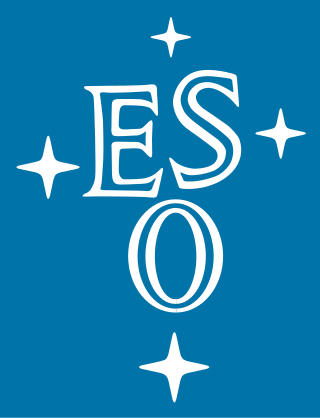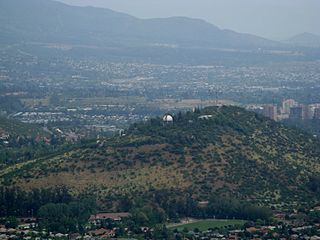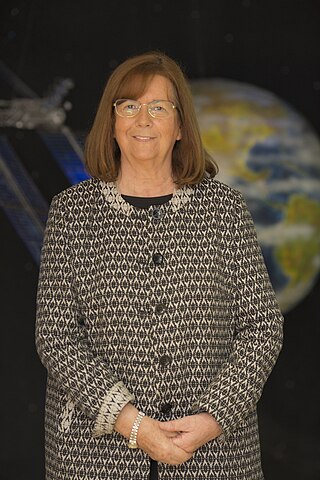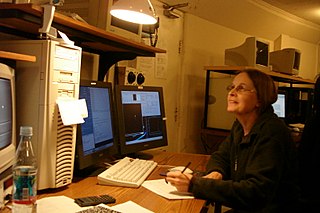
The European Organisation for Astronomical Research in the Southern Hemisphere, commonly referred to as the European Southern Observatory (ESO), is an intergovernmental research organisation made up of 16 member states for ground-based astronomy. Created in 1962, ESO has provided astronomers with state-of-the-art research facilities and access to the southern sky. The organisation employs over 750 staff members and receives annual member state contributions of approximately €162 million. Its observatories are located in northern Chile.

The Cerro Tololo Inter-American Observatory (CTIO) is an astronomical observatory located on the summit of Mt. Cerro Tololo in the Coquimbo Region of northern Chile, with additional facilities located on Mt. Cerro Pachón about 10 kilometres (6.2 mi) to the southeast. It is approximately 80 kilometres (50 mi) east of La Serena, where support facilities are located. The principal telescopes at CTIO are the 4 m Víctor M. Blanco Telescope, named after Puerto Rican astronomer Víctor Manuel Blanco, and the 4.1 m Southern Astrophysical Research Telescope, which is situated on Cerro Pachón. Other telescopes on Cerro Tololo include the 1.5 m, 1.3 m, 1.0 m, and 0.9 m telescopes operated by the SMARTS consortium. CTIO also hosts other research projects, such as PROMPT, WHAM, and LCOGTN, providing a platform for access to the southern hemisphere for U.S. and worldwide scientific research.

La Silla Observatory is an astronomical observatory in Chile with three telescopes built and operated by the European Southern Observatory (ESO). Several other telescopes are also located at the site and are partly maintained by ESO. The observatory is one of the largest in the Southern Hemisphere and was the first in Chile to be used by ESO.

Paranal Observatory is an astronomical observatory operated by the European Southern Observatory (ESO). It is located in the Atacama Desert of Northern Chile on Cerro Paranal at 2,635 m (8,645 ft) altitude, 120 km (70 mi) south of Antofagasta. By total light-collecting area, it is the largest optical-infrared observatory in the Southern Hemisphere; worldwide, it is second to the Mauna Kea Observatory on Hawaii.

Llano de Chajnantor Observatory is the name for a group of astronomical observatories located at an altitude of over 4,800 m (15,700 ft) in the Atacama Desert of northern Chile. The site is in the Antofagasta Region approximately 50 kilometres (31 mi) east of the town of San Pedro de Atacama. The exceptionally arid climate of the area is inhospitable to humans, but creates an excellent location for millimeter, submillimeter, and mid-infrared astronomy. This is because water vapour absorbs and attenuates submillimetre radiation. Llano de Chajnantor is home to the largest and most expensive astronomical telescope project in the world, the Atacama Large Millimeter Array (ALMA). Llano de Chajnantor and the surrounding area has been designated as the Chajnantor Science Reserve by the government of Chile.

Las Campanas Observatory (LCO) is an astronomical observatory managed by the Carnegie Institution for Science (CIS). Located in Chile's Atacama Region, it sits about 100 kilometres (62 mi) northeast of the city of La Serena. The LCO's telescopes and facilities are positioned near the northern end of a 7 km (4.3 mi) mountain ridge. Cerro Las Campanas, situated near the southern end of this ridge and standing over 2,500 m (8,200 ft) tall, will be the future site of the Giant Magellan Telescope.

The High-Z Supernova Search Team was an international cosmology collaboration which used Type Ia supernovae to chart the expansion of the universe. The team was formed in 1994 by Brian P. Schmidt, then a post-doctoral research associate at Harvard University, and Nicholas B. Suntzeff, a staff astronomer at the Cerro Tololo Inter-American Observatory (CTIO) in Chile. The original team submitted a proposal on September 29, 1994 called A Pilot Project to Search for Distant Type Ia Supernova to the CTIO. The team on the first observing proposal comprised: Nicholas Suntzeff (PI); Brian Schmidt (Co-I); R. Chris Smith, Robert Schommer, Mark M. Phillips, Mario Hamuy, Roberto Aviles, Jose Maza, Adam Riess, Robert Kirshner, Jason Spiromilio, and Bruno Leibundgut. The project was awarded four nights of telescope time on the CTIO Víctor M. Blanco Telescope on the nights of February 25, 1995, and March 6, 24, and 29, 1995. The pilot project led to the discovery of supernova SN1995Y. In 1995, the HZT elected Brian P. Schmidt of the Mount Stromlo Observatory which is part of the Australian National University to manage the team.

Cerro Pachón is a mountain in central Chile, located east of the city of La Serena in the Coquimbo Region. The mountain is seismically active. It is the site of the 8.1 m Gemini South Telescope of the Gemini Observatory, and the 4.1 m SOAR optical imager. As of 2020, the Vera C. Rubin Observatory is being constructed at this site.

Víctor Manuel Blanco was a Puerto Rican astronomer who in 1959 discovered Blanco 1, a stellar cluster. Blanco was the second Director of the Cerro Tololo Inter-American Observatory in Chile, which had the largest telescope in the Southern Hemisphere at the time. In 1995, the 4-meter telescope was dedicated in his honor and named the Víctor M. Blanco Telescope; it is also known as the "Blanco 4m."

Mario Andrés Hamuy Wackenhut is a Chilean Astronomer and Professor of Astronomy at the University of Chile and Cerro Calan Observatory. He is well known for his observational work on all classes of supernovae, especially the use of Type Ia and Type II supernovae as measures of cosmic distance.

The Calán/Tololo Supernova Survey was a supernova survey that ran from 1989 to 1995 at the University of Chile and the Cerro Tololo Inter-American Observatory to measure a Hubble diagram out to redshifts of 0.1. It was founded by Mario Hamuy, José Maza Sancho, Mark M. Phillips, and Nicholas B. Suntzeff in 1989 out of discussions at the UC Santa Cruz meeting on supernovae on how to improve the Hubble diagram using Type Ia supernovae. It was also motivated by the suggestion of Allan Sandage to restart a supernova survey after the Sandage and Tammann survey failed due to poor quality photographic plates in 1986. The Survey built on the original supernova survey of Maza done at the f/3 Maksutov Camera at the Cerro Roble Observatory of the University of Chile between 1979 and 1984. The Survey used the CTIO Curtis Schmidt telescope with IIa-O photographic plates, each plate covering a field of 25 sq-deg on the sky. The plates were developed and sent to Santiago Chile the next morning and searched for supernovae at the Department of Astronomy at the University of Chile. Any supernova candidates were then observed the next night using the 0.9m telescope at CTIO with a CCD camera. This was one of the first studies done in astronomy where the telescope time was scheduled to observe objects not yet discovered.

Cerro Armazones is a mountain located in the Sierra Vicuña Mackenna of the Chilean Coast Range of the Andes, approximately 130 km (81 mi) southeast of Antofagasta in the Antofagasta Region, Chile. The mountain is situated in an ideal location for optical astronomy due to its 89% cloudless nights annually. On 26 April 2010, the European Southern Observatory Council selected Cerro Armazones as the site for the planned Extremely Large Telescope (ELT); construction commenced in June 2014. The first light observation is scheduled for 2027.
The Confederation of Chilean Students is a student organization in Chile that congregates the student federations of universities in Chile.

Cerro Murphy Observatory is an international astrophysical project hosted by the ESO Paranal Observatory and operated by the Nicolaus Copernicus Astronomical Center of the Polish Academy of Sciences. The observatory is located on Cerro Murphy, which is a hill located 1 kilometre to the southwest and 230 metres (750 ft) below the summit of Cerro Armazones, a mountain in the Antofagasta Region of Chile, 120 km (75 mi) south of Antofagasta. OCM is located at 2,817 m (9,242 ft) altitude and currently houses 5 telescopes, whose diameters range between 0.3 and 1.5 m.

The National Astronomical Observatory of Chile is an astronomical observatory owned and operated by the Department of Astronomy of the University of Chile (UCh). It is located on Cerro Calán, a hill in the commune of Las Condes. The commune is an eastern suburb of Santiago located in Santiago Province of the Santiago Metropolitan Region. OAN was founded in 1852 and became a part of UCh in 1927. The facility on Cerro Calán was completed in 1962.

María Teresa Ruiz is a Chilean astronomer who was the first woman to receive Chile's National Prize for Exact Sciences, the first female recipient of a doctorate in astrophysics at Princeton University, and the first woman president of the Chilean Academy of Sciences. She is known, too, for the discovery of the brown dwarf Kelu-1.
The Instituto de Astronomía Teórica y Experimental (IATE) is a scientific institute funded by the Consejo Nacional de Investigaciones en Científicas y Técnicas (CONICET) and the Universidad Nacional de Córdoba (UNC), located in the city of Córdoba, Argentina, and dedicated to the study of different topics in astronomy. The headquarters of the institute are located at the Observatorio Astronómico de Córdoba.

Carmen Adelina Gutiérrez Alonso was a Chilean scientist, academic and professor of astrophysics. She was the first Chilean to obtain a doctoral degree in astrophysics and the first woman to become a member of the Chilean Academy of Sciences.

José María Maza Sancho is a Chilean astronomer and astrophysicist. His work has focused on the study of supernovas, the execution of a search for objects with emission lines, dark energy, and quasars with an objective prism, which led him to be awarded the National Prize for Exact Sciences in 1999. Since 2017 he gained popular following with books aimed to the general public and podcasts.

Nidia Irene Morrell is an Argentine astronomer who is a permanent staff member at the Las Campanas Observatory in La Serena, Chile. She was a member of the Massive Stars research group led by Virpi Niemelä and the Hubble Heritage Project. Professionally, she is known for her numerous contributions related to the astrophysics of massive stars. She participates in the systematic search for variations of brightness in stellar objects, including the observation of a candidate for the Thorne–Żytkow object. She was also a member of the team that discovered the supernova ASASSN-15lh.



















